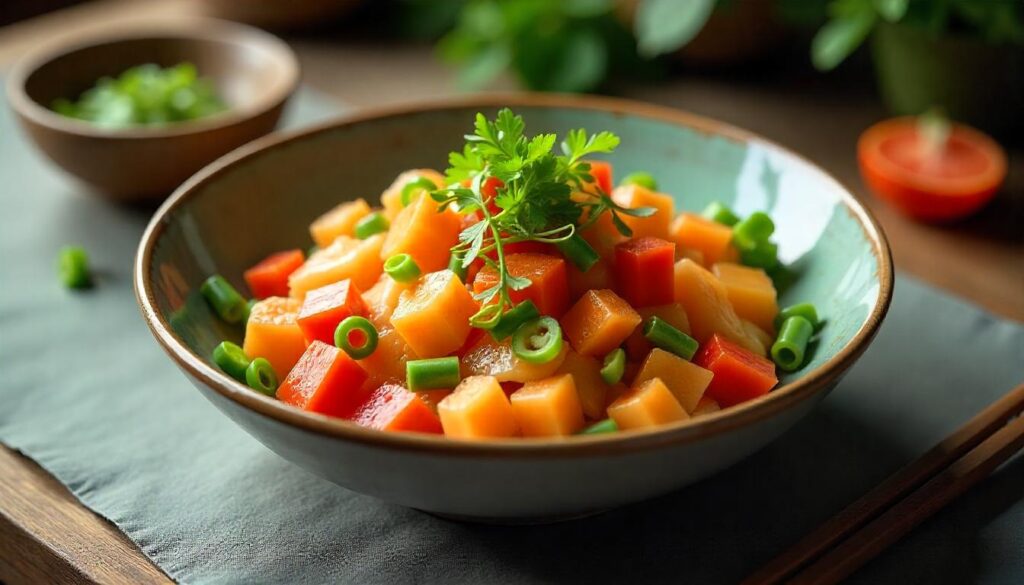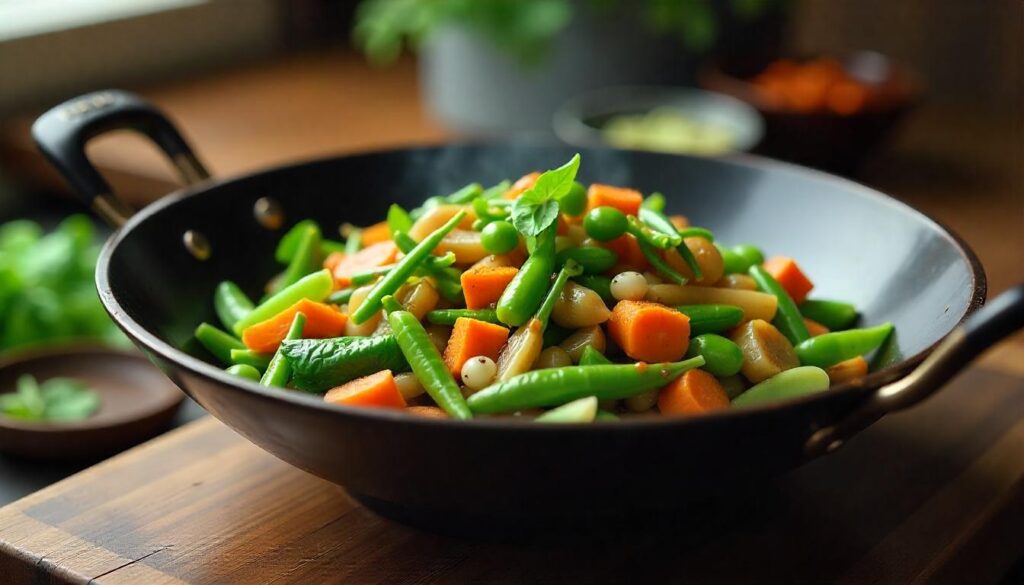Japanese cuisine is celebrated worldwide for its emphasis on fresh ingredients, balanced flavors, and artistic presentation. Among its many delights, vegetables japanese recipe stands out as a testament to the elegance and simplicity that defines traditional Japanese cooking. Whether you’re a seasoned chef or a home cook eager to explore new culinary horizons, mastering Japanese vegetable dishes can elevate your kitchen repertoire and provide nourishing, delicious meals.
Vegetables play a pivotal role in Japanese meals, not just as side dishes but as integral components that enhance the overall dining experience. From vibrant salads to savory stir-fries, Japanese vegetable recipes offer a unique blend of taste, texture, and health benefits. This comprehensive guide will delve into various aspects of Japanese vegetable cooking, providing you with the knowledge and techniques to create authentic dishes that can rival those found in esteemed Japanese restaura

Introduction
Japanese cuisine is celebrated worldwide for its emphasis on fresh ingredients, balanced flavors, and artistic presentation. Among its many delights, vegetables japanese recipe stands out as a testament to the elegance and simplicity that defines traditional Japanese cooking. Whether you’re a seasoned chef or a home cook eager to explore new culinary horizons, mastering Japanese vegetable dishes can elevate your kitchen repertoire and provide nourishing, delicious meals.
Vegetables play a pivotal role in Japanese meals, not just as side dishes but as integral components that enhance the overall dining experience. From vibrant salads to savory stir-fries, Japanese vegetable recipes offer a unique blend of taste, texture, and health benefits. This comprehensive guide will delve into various aspects of Japanese vegetable cooking, providing you with the knowledge and techniques to create authentic dishes that can rival those found in esteemed Japanese restaurants.

For more advanced vegetable techniques, see our Authentic Japanese Short Ribs Recipe.
Types of Japanese Vegetable Recipes
Japanese cuisine offers a diverse array of vegetables japanese recipe, each with its unique flavor profile and preparation method. Understanding these different types can help you diversify your meals and appreciate the rich culinary heritage of Japan.
Stir-Fried Vegetables
One of the most common ways to prepare vegetables in Japanese cuisine is through stir-frying. This technique allows vegetables to retain their natural crunch and vibrant colors while absorbing the savory flavors of the sauces used.
- Common Dishes:
- Yasai Itame: A medley of vegetables like bell peppers, carrots, and mushrooms stir-fried with soy sauce and mirin.
- Nasu Dengaku: Grilled eggplant topped with a sweet miso glaze.

Pickles (Tsukemono)
Pickles, or tsukemono, are an essential part of Japanese cuisine, offering a tangy and refreshing contrast to the rest of the meal. They are typically made by fermenting vegetables in brine or rice vinegar.
- Common Dishes:
- Takuan: Pickled daikon radish, known for its bright yellow color and sweet-sour taste.
- Umeboshi: Salty and sour pickled plums, often served with rice.
Salads
Japanese salads emphasize fresh, crisp vegetables dressed in light, flavorful dressings. They are often garnished with sesame seeds or dried seaweed to add texture and depth.
- Common Dishes:
- Sunomono: Cucumber salad with a vinegar-based dressing.
- Goma-ae: Blanched spinach dressed with a sweet sesame sauce.
Simmered Dishes (Nimono)
Nimono refers to vegetables that are simmered in a seasoned broth, allowing them to absorb the flavors of the sauce. This method results in tender, flavorful vegetables that complement the meal.
- Common Dishes:
- Nimono: A variety of vegetables like potatoes, carrots, and lotus root simmered in soy sauce, mirin, and dashi.
- Kabocha Nimono: Simmered Japanese pumpkin, sweet and tender.
For more sauce options, check out our Bachan’s Japanese Sauce Recipes for enhancing your sauces.
Essential Ingredients in Japanese Vegetable Recipes
The foundation of vegetables japanese recipe lies in the quality and balance of ingredients used. Key components include:
Soy Sauce (Shoyu)
Soy sauce, or shoyu, is a staple in Japanese cooking, providing a salty and umami-rich base for many dishes. It enhances the natural flavors of vegetables without overpowering them.
Mirin
Mirin is a sweet rice wine used to add sweetness and depth to sauces and marinades. It balances the saltiness of soy sauce, creating a well-rounded flavor.
Dashi
Dashi is a savory broth made from kombu (sea kelp) and bonito flakes. It forms the backbone of many Japanese sauces and provides a subtle umami flavor that complements vegetables.
Sesame Oil
Sesame oil adds a rich, nutty aroma to dishes. It is commonly used in dressings and stir-fries to enhance the overall flavor.
Fresh Aromatics (Garlic, Ginger)
Fresh aromatics like garlic and ginger are essential for infusing dishes with aromatic flavors. They add complexity and a subtle heat that elevates the taste of the vegetables.
For more sauce options, explore our Bachan’s Japanese Sauce Recipes which offers a variety of sauces to complement your vegetables.
Techniques for Preparing Japanese Vegetables
Mastering the techniques used in Japanese vegetable recipes is crucial for achieving authentic flavors and textures. These methods ensure that the vegetables are prepared in a way that highlights their natural qualities while enhancing them with complementary flavors.
Slicing and Dicing
Proper slicing and dicing of vegetables are fundamental in Japanese cooking. Uniform cuts ensure even cooking and a pleasing presentation.
- Tips:
- Use a sharp knife to make clean, precise cuts.
- Follow specific cutting techniques like julienne or chiffonade for different dishes.
Marinating
Marinating vegetables in seasoned liquids infuses them with rich flavors. This technique is often used for pickles and salads.
- Steps:
- Combine soy sauce, mirin, and other seasonings.
- Submerge the vegetables in the marinade.
- Allow them to sit for a specified period to absorb the flavors.
Simmering
Simmering is a gentle cooking method that allows vegetables to become tender while absorbing the flavors of the broth or sauce.
- Process:
- Prepare a seasoned broth with soy sauce, mirin, and dashi.
- Add the vegetables and simmer until they are tender.
- Adjust seasoning as needed.
Grilling
Grilling vegetables imparts a smoky flavor and enhances their natural sweetness. This technique is often used for dishes like nasu dengaku.
- Method:
- Preheat the grill to medium-high heat.
- Brush the vegetables with sesame oil or miso glaze.
- Grill until they are charred and tender.
Blanching
Blanching involves briefly boiling vegetables and then plunging them into ice water. This technique preserves their color and crispness.
- Usage:
- Ideal for salads and dishes like goma-ae.
- Ensures vegetables remain vibrant and fresh-tasting.
Nutritional Benefits of Japanese Vegetable Recipes
Japanese vegetable recipes are not only flavorful but also packed with nutritional benefits. Incorporating these dishes into your diet can contribute to overall health and well-being.
Low-Calorie
Japanese vegetable dishes are typically low in calories, making them an excellent choice for those looking to maintain a healthy weight.
- Benefits:
- Supports weight management without sacrificing flavor.
- Ideal for balanced, portion-controlled meals.
Rich in Vitamins and Minerals
Vegetables used in Japanese recipes are rich in essential vitamins and minerals, contributing to various bodily functions.
- Key Nutrients:
- Vitamin C: Boosts the immune system and promotes skin health.
- Vitamin A: Supports vision and immune function.
- Iron: Essential for blood health and energy production.
Heart Health
Many Japanese vegetable dishes are heart-healthy, thanks to ingredients like sesame oil and fresh vegetables that promote cardiovascular well-being.
- Benefits:
- Reduces bad cholesterol levels.
- Enhances blood circulation.
Weight Management
The combination of low-calorie ingredients and high fiber content in Japanese vegetable recipes aids in weight management by promoting satiety and reducing overall calorie intake.
- Benefits:
- Helps in feeling full longer.
- Supports metabolic health.
History and Examples
Culinary Beginnings
Japanese vegetable recipes have a rich history that reflects the country’s culinary evolution. Traditional Japanese cuisine, known as washoku, emphasizes seasonal ingredients and balance, principles that have shaped the way vegetables are prepared and enjoyed.
Historically, vegetables were a staple in the Japanese diet, especially in rural areas where farming was prevalent. Techniques like pickling and simmering were developed as preservation methods, allowing vegetables to be enjoyed throughout the year. The introduction of new vegetables from other countries during the Meiji Restoration further diversified Japanese vegetable dishes, blending traditional methods with new flavors and ingredients.

Practical Examples/Use Cases
Japanese vegetable recipes are versatile and can be adapted to various meal settings, from everyday home-cooked meals to formal dining experiences.
- Everyday Meals: Simple stir-fries and salads make for quick and nutritious additions to daily meals.
- Festive Dishes: Special occasions feature elaborate vegetable dishes like tempura and tsukemono to celebrate the season and enhance the dining experience.
- Health-Conscious Meals: With the rising popularity of plant-based diets, Japanese vegetable recipes offer healthy, flavorful options that cater to modern dietary preferences.

For more creative pairings, explore our Minced Beef Japanese Recipe to add another layer of flavor to your meals.
Frequently Asked Questions (FAQs)
1. What are the most popular Japanese vegetable recipes?
Some of the most popular Japanese vegetable recipes include stir-fried vegetables (yasai itame), pickles (tsukemono), salads like sunomono, and simmered dishes (nimono) such as kabocha nimono.
2. Are Japanese vegetable recipes healthy?
Yes, Japanese vegetable recipes are generally healthy, as they emphasize fresh ingredients, minimal use of unhealthy fats, and a balance of flavors that promote nutritional well-being.
3. How can I make Japanese vegetable recipes more flavorful?
To enhance the flavor of Japanese vegetable recipes, use authentic ingredients like soy sauce, mirin, and dashi, and incorporate aromatics such as garlic and ginger. Marinating vegetables before cooking can also infuse them with rich flavors.
4. Can I substitute ingredients in Japanese vegetable recipes?
Yes, you can substitute ingredients based on dietary preferences or availability. For example, you can use tamari instead of soy sauce for a gluten-free option or honey instead of sugar for a natural sweetener. However, substitutions may slightly alter the flavor, so adjust quantities to taste.
5. How do I store leftover Japanese vegetable dishes?
Leftover Japanese vegetable dishes should be stored in sterilized containers and refrigerated promptly. Most dishes can last 1-2 weeks in the refrigerator. Always check for signs of spoilage before consuming.
6. What equipment do I need to prepare Japanese vegetable recipes?
Essential equipment includes a sharp knife for slicing and dicing, a wok or heavy-bottomed skillet for stir-frying, measuring cups and spoons, a grater for aromatics, and resealable plastic bags or shallow dishes for marinating.
7. Where can I find authentic Japanese ingredients for vegetable recipes?
Authentic Japanese ingredients can be found at Asian grocery stores, specialty markets, or online retailers. Look for high-quality soy sauce, mirin, dashi, and fresh aromatics to ensure the best flavors in your dishes.

Conclusion
Vegetables Japanese recipe offers a gateway to authentic and versatile flavors that can transform your culinary creations. From simple stir-fries to intricate pickles, these recipes are indispensable in both traditional and modern dishes. By incorporating the techniques and ingredients discussed in this guide, you can effortlessly recreate these vegetable dishes at home, bringing the essence of Japanese cuisine to your kitchen.
Final Thoughts: Don’t hesitate to experiment with these recipes and discover your favorite combinations. Japanese vegetable dishes are not only delicious but also provide a foundation for endless culinary possibilities.
Call-to-Action (CTA):
- Did you try this recipe? Share your tips or feedback in the comments!
- Subscribe to our newsletter for more authentic recipes and culinary tips.
- Follow us on social media for updates and additional cooking inspiration.

